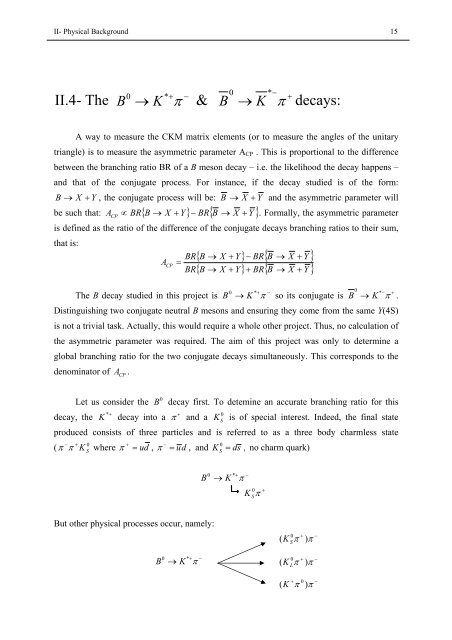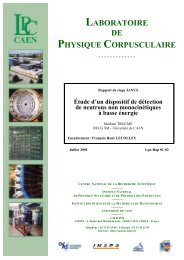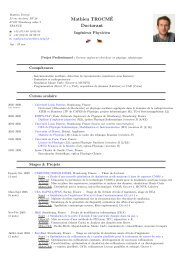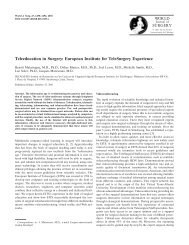Rare B meson decays - mathieu trocmé
Rare B meson decays - mathieu trocmé
Rare B meson decays - mathieu trocmé
You also want an ePaper? Increase the reach of your titles
YUMPU automatically turns print PDFs into web optimized ePapers that Google loves.
II- Physical Background 15<br />
0 * + −<br />
+<br />
II.4- The B → K π & B → K π <strong>decays</strong>:<br />
A way to measure the CKM matrix elements (or to measure the angles of the unitary<br />
triangle) is to measure the asymmetric parameter ACP . This is proportional to the difference<br />
between the branching ratio BR of a B <strong>meson</strong> decay – i.e. the likelihood the decay happens –<br />
and that of the conjugate process. For instance, if the decay studied is of the form:<br />
B → X + Y , the conjugate process will be: B → X + Y and the asymmetric parameter will<br />
be such that: ACP ∝ BR{<br />
B → X + Y}<br />
− BR{<br />
B → X + Y } . Formally, the asymmetric parameter<br />
is defined as the ratio of the difference of the conjugate <strong>decays</strong> branching ratios to their sum,<br />
that is:<br />
A CP<br />
BR<br />
=<br />
BR<br />
0<br />
* −<br />
{ B → X + Y}<br />
− BR{<br />
B → X + Y }<br />
{ B → X + Y}<br />
+ BR{<br />
B → X + Y }<br />
0 * + −<br />
* − +<br />
The B decay studied in this project is B → K π so its conjugate is B → K π .<br />
Distinguishing two conjugate neutral B <strong>meson</strong>s and ensuring they come from the same Y(4S)<br />
is not a trivial task. Actually, this would require a whole other project. Thus, no calculation of<br />
the asymmetric parameter was required. The aim of this project was only to determine a<br />
global branching ratio for the two conjugate <strong>decays</strong> simultaneously. This corresponds to the<br />
denominator of A CP .<br />
0<br />
Let us consider the B decay first. To detemine an accurate branching ratio for this<br />
* +<br />
decay, the K decay into a +<br />
0<br />
π and a K S is of special interest. Indeed, the final state<br />
produced consists of three particles and is referred to as a three body charmless state<br />
− + 0<br />
+<br />
−<br />
0<br />
( π π K where π = ud<br />
, π = ud<br />
, and K S = ds<br />
, no charm quark)<br />
S<br />
But other physical processes occur, namely:<br />
B<br />
0 * + −<br />
→ K π<br />
B<br />
0 * + −<br />
→ K π<br />
0<br />
K S<br />
+<br />
π<br />
( K<br />
( K<br />
0<br />
S<br />
0<br />
L<br />
π )<br />
+ −<br />
π<br />
π )<br />
+ −<br />
π<br />
+ 0 −<br />
( K π ) π<br />
0






